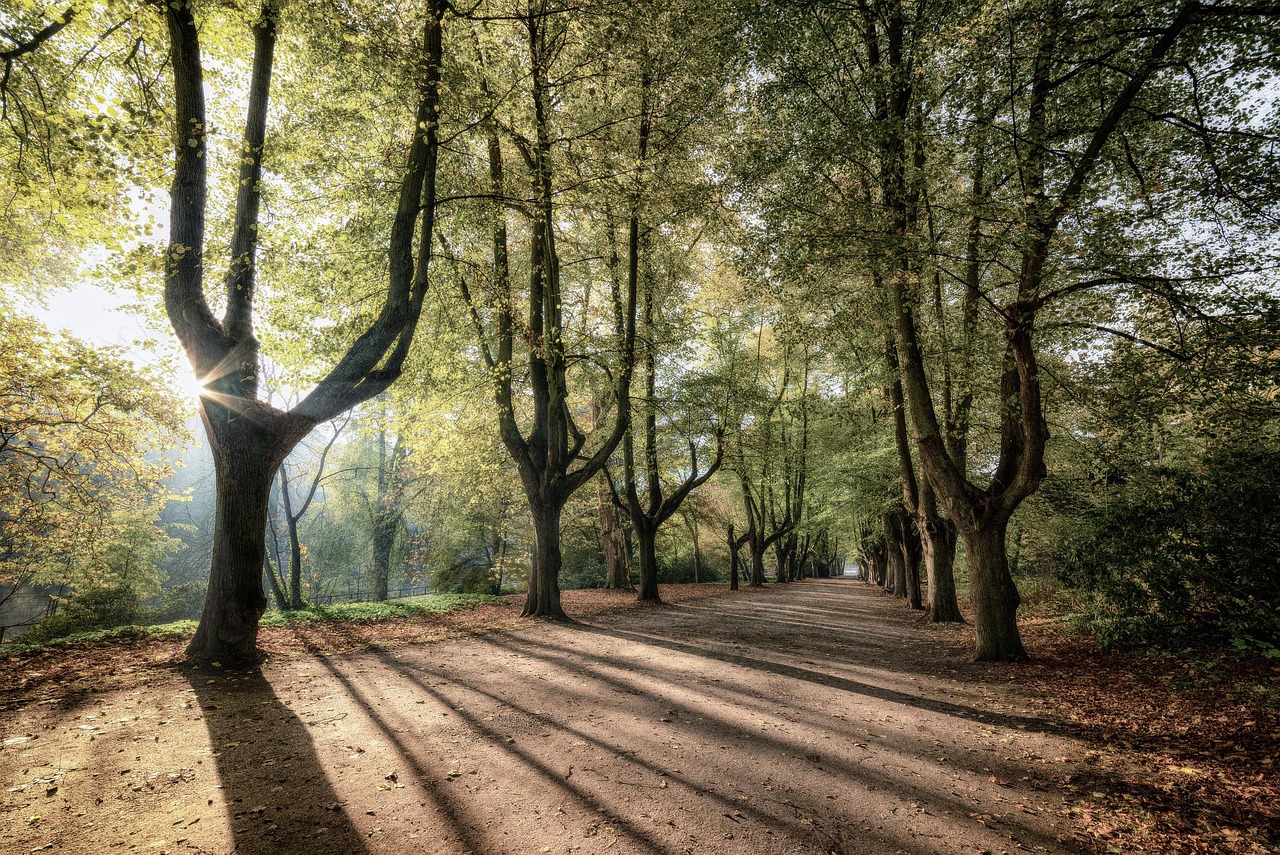The shadow of a tree significantly impacts its surrounding space by influencing light availability, temperature, and moisture levels. These changes affect the growth of other plants, the behavior of wildlife, and the overall ecosystem dynamics in the area.
Trees are vital components of our environment. They provide shade, enhance aesthetics, and support biodiversity. The shadow cast by a tree is not just an absence of light; it creates a unique microenvironment that can alter conditions for other living organisms nearby. Understanding how tree shadows affect their surroundings helps us appreciate these natural giants even more.

Shadows are formed when an object blocks sunlight. The size and shape of a tree’s shadow depend on several factors, including the tree’s height, canopy size, and the position of the sun in the sky. As the sun moves throughout the day, the angle of light changes, causing shadows to shift and alter in length. This dynamic can create varying conditions for plants and animals in the vicinity.
How Tree Shadows Affect Surrounding Plants
The presence of a tree’s shadow can significantly influence other plants growing nearby. Some plants thrive in shaded areas, while others may struggle due to low light conditions. Here are some ways tree shadows impact surrounding vegetation:
- Light Availability: Shaded areas receive less direct sunlight, which can hinder photosynthesis in sun-loving plants. Conversely, shade-tolerant plants benefit from reduced light intensity.
- Temperature Regulation: Tree shadows help cool the ground beneath them. This cooler environment can be beneficial for certain plant species that prefer lower temperatures.
- Moisture Retention: A shaded area often retains moisture better than exposed ground. This retention can favor plants that require consistent moisture levels.
In some cases, tree shadows can create a competitive environment. For instance, fast-growing plants may overshadow slower-growing species, limiting their access to light and resources. Understanding these dynamics is essential for gardeners and landscapers who aim to cultivate diverse plant life.

The Impact on Wildlife
The shadow of a tree also plays a critical role in shaping the habitat for various wildlife species. The microclimate created by tree shadows can attract different animals and insects, influencing their behavior and feeding patterns. Here are some effects on wildlife:
- Habitat Creation: Trees provide shelter for birds and small mammals, creating safe spaces from predators.
- Feeding Opportunities: Many insects and animals are drawn to shaded areas where food sources are abundant, including fruits, nuts, and foliage.
- Breeding Grounds: The cooler, moist environment under a tree’s shadow may serve as a suitable breeding ground for certain species.
Understanding how the shadow of a tree affects wildlife is crucial for conservation efforts. Protecting these habitats ensures that ecosystems remain balanced and diverse.
The Role of Shadows in Urban Environments
In urban settings, tree shadows have additional implications. As cities grow and develop, maintaining green spaces becomes essential for enhancing urban life quality. Tree shadows contribute to urban cooling, reducing heat island effects in densely populated areas. Here are some urban benefits of tree shadows:

- Energy Savings: Buildings shaded by trees often require less energy for cooling during hot months.
- Enhanced Aesthetics: Tree-lined streets create visually appealing environments that encourage outdoor activities.
- Improved Air Quality: Trees can filter pollutants from the air, leading to healthier urban spaces.
Urban planners and landscape architects often consider tree placement strategically to maximize these benefits. Well-placed trees not only enhance the visual appeal of a city but also contribute to its environmental sustainability.
In summary, the shadow cast by trees plays a pivotal role in shaping the environment around them. From influencing plant growth to providing habitats for wildlife and enhancing urban landscapes, understanding this phenomenon is essential in various fields such as ecology, horticulture, and urban planning.
The Effects of Tree Shadows on Soil and Water
The shadow of a tree not only affects plants and wildlife but also plays a significant role in soil health and water retention. The microenvironment created under the tree canopy can influence soil composition, moisture levels, and overall ecosystem health.

Soil Composition and Fertility
Tree shadows create distinct soil conditions that can affect plant growth. The following factors are essential to consider when examining the impact of tree shadows on soil:
- Organic Matter Accumulation: Leaves and branches that fall under a tree’s shadow decompose over time. This process enriches the soil with organic matter, improving fertility and structure.
- Soil Temperature: Shaded soil is typically cooler than exposed soil. This temperature difference can affect microbial activity and nutrient availability, which are crucial for plant growth.
- pH Levels: The decomposition of leaf litter may alter the pH of the soil, making it more acidic or alkaline depending on the tree species. This change can influence the types of plants that thrive nearby.
These variations in soil conditions highlight the importance of trees in promoting healthy ecosystems. Understanding these relationships can aid in better land management practices.
Water Retention and Drainage
The shadow of a tree can greatly impact water retention in the soil. Here are some ways that tree shadows contribute to moisture management:
- Reduced Evaporation: Trees provide shade, which can significantly lower evaporation rates from the soil. This effect is particularly beneficial in arid regions where water conservation is critical.
- Increased Percolation: The roots of trees help improve soil structure. This enhancement allows water to percolate more effectively, reducing surface runoff and promoting groundwater recharge.
- Moisture Consistency: Shaded areas tend to maintain more consistent moisture levels. This stability is advantageous for plants that require regular watering.
The interplay between tree shadows and water dynamics is essential for sustaining healthy plant life and preventing soil erosion.
Tree Shadows and Climate Regulation
Tree shadows serve as natural climate regulators, influencing local weather patterns and microclimates. This regulation has broader implications for environmental health and biodiversity.
Temperature Moderation
Shaded areas created by trees tend to have more moderate temperatures compared to open spaces. This temperature regulation can lead to various benefits:
- Habitat Diversity: Different species of plants and animals prefer varying temperature ranges. Tree shadows create microhabitats that support diverse organisms.
- Seasonal Effects: The cooling effect of tree shadows can delay the onset of spring in shaded areas, affecting blooming times and seasonal behaviors among flora and fauna.
- Urban Heat Island Mitigation: In cities, tree shadows can help mitigate the urban heat island effect, where urban areas become significantly warmer than their rural surroundings due to human activities.
Air Quality Improvement
Trees play a vital role in improving air quality through their shadow effects. The benefits include:
- Pollutant Filtration: Tree leaves filter dust, smoke, and other airborne particles, leading to cleaner air in shaded areas compared to those exposed to direct sunlight.
- Carbon Sequestration: Trees absorb carbon dioxide during photosynthesis. The presence of trees in an area contributes to lower carbon levels in the atmosphere, which is crucial for combating climate change.
- Oxygen Production: Through photosynthesis, trees release oxygen into the atmosphere, improving air quality and supporting life.
The benefits of tree shadows extend beyond individual trees to support overall environmental health. Recognizing their role in climate regulation is essential for effective conservation efforts.
Tree Shadows in Landscape Design
The significance of tree shadows extends into landscape design, where they are strategically utilized to enhance outdoor spaces. Designers consider several factors when incorporating trees into landscapes:
- Aesthetic Appeal: Trees add beauty to gardens and parks. Their shadows create patterns on the ground that can enhance visual interest.
- Functional Spaces: Shaded areas can serve as outdoor gathering spots or recreational spaces, making landscapes more inviting and usable.
- Sustainable Design: Incorporating trees into landscapes promotes biodiversity, improves air quality, and aids in stormwater management.
Incorporating tree shadows into landscape planning requires an understanding of tree placement, species selection, and ongoing maintenance to maximize benefits while minimizing issues such as root intrusion or excessive shade.
The Cultural and Psychological Impact of Tree Shadows
Tree shadows do not only have ecological and aesthetic significance; they also play a role in cultural and psychological aspects of human life. The presence of trees and their shadows can influence how people interact with their environment and enhance well-being.
Cultural Significance of Trees
Trees have been symbols of strength, endurance, and wisdom in various cultures throughout history. Their shadows often hold cultural meanings that affect how they are perceived in different societies:
- Spiritual and Religious Symbolism: Many cultures view trees as sacred. For instance, in some indigenous traditions, trees are seen as the connection between heaven and earth.
- Art and Literature: Trees and their shadows have inspired countless works of art and literature. They are often depicted as places of reflection, shelter, or mystery.
- Community Gathering Spaces: In many cultures, shaded areas created by trees serve as communal gathering spots for social interactions, storytelling, and cultural rituals.
Understanding the cultural significance of trees can enhance community engagement and promote conservation efforts. Celebrating local tree species can strengthen community identity and pride.
Psychological Benefits of Tree Shadows
The psychological impact of tree shadows can be profound. Research has shown that green spaces and shaded areas have several mental health benefits:
- Stress Reduction: Spending time in shaded areas can lower stress levels. The calming effect of nature encourages relaxation and mental clarity.
- Enhanced Mood: Exposure to green environments has been linked to improved mood and reduced symptoms of anxiety and depression.
- Increased Creativity: Natural settings can inspire creativity. Many people find that being in a shaded area allows for better focus and innovative thinking.
These psychological benefits highlight the importance of incorporating tree shadows into urban planning and community design to foster healthier populations.
The Role of Tree Shadows in Agriculture
Tree shadows also play a significant role in agriculture, particularly in agroforestry systems where trees are integrated into farming landscapes. The benefits include:
Shade Tolerance for Crops
Many crops can benefit from the shade provided by trees. Here’s how:
- Temperature Regulation: Shade can protect sensitive crops from excessive heat, preventing stress and potential crop failure during hot days.
- Moisture Conservation: Similar to their effects on soil moisture, tree shadows can help retain water in agricultural fields, particularly in dry climates.
- Pest Control: Certain pests thrive in full sunlight. Trees can provide natural pest control by creating an environment less favorable for these pests.
Crop Diversity
The integration of trees into agricultural practices can lead to increased biodiversity among crops. This diversity offers several advantages:
- Soil Health: Different plant species contribute to nutrient cycling and improve soil structure through their varying root systems.
- Pest Resilience: Diverse cropping systems are generally more resilient to pests and diseases, reducing the need for chemical interventions.
- Economic Benefits: Farmers can diversify their income streams by producing multiple types of crops along with timber or fruit from trees.
Environmental Challenges Related to Tree Shadows
Despite the many benefits tree shadows provide, there are environmental challenges that arise with tree growth and shadow coverage. Understanding these challenges is essential for sustainable management practices.
Invasive Species Concerns
Some tree species can be invasive, negatively impacting native plants and ecosystems. These invasives can alter light availability and moisture levels in ways that disrupt the local flora:
- Competition for Resources: Invasive trees may outcompete native species for sunlight, nutrients, and water, leading to reduced biodiversity.
- Soil Alteration: The presence of invasive tree roots can change soil chemistry, affecting the growth of surrounding plants.
- Pest Attraction: Some invasive trees may attract pests that further threaten local ecosystems.
Management Strategies
To mitigate the challenges posed by invasive tree species while maximizing the benefits of tree shadows, effective management strategies must be employed:
- Monitoring and Assessment: Regular assessments of tree populations can identify invasive species early, allowing for timely intervention.
- Selective Planting: Choose native or non-invasive species for planting to enhance biodiversity while maintaining ecological balance.
- Ecosystem Restoration: Engage in restoration projects that focus on removing invasive species and reintroducing native vegetation.
The management of tree shadows requires a balanced approach, considering both the environmental benefits they provide and the challenges they may introduce.
Future Research Directions
As we continue to explore the effects of tree shadows on surrounding spaces, several areas warrant further research. Ongoing studies can help deepen our understanding of the complex relationships between trees, their shadows, and the ecosystems they influence.
Climate Change Impacts
One vital area of research involves understanding how climate change affects tree growth and shadow dynamics. Key points to consider include:
- Species Adaptability: Investigating how different tree species adapt to changing climates can inform future planting strategies.
- Shadow Dynamics: Assessing how shifts in climate impact the size and shape of tree shadows can offer insights into their effects on local ecosystems.
- Urban Heat Islands: Exploring the role of tree shadows in mitigating urban heat islands under various climate scenarios can guide urban planning efforts.
Biodiversity Studies
Researching the relationship between tree shadows and biodiversity can provide valuable insights. Areas of focus may include:
- Microhabitats: Understanding how tree shadows create microhabitats that support diverse plant and animal species.
- Pollinator Behavior: Studying how shaded areas affect the behavior and health of pollinators can enhance agricultural practices.
- Invasive Species Monitoring: Investigating how invasive species interact with native flora and fauna in shaded environments can lead to better management strategies.
Sustainable Practices in Agriculture
The integration of trees into agricultural landscapes is an area ripe for further exploration. Research could focus on:
- Agricultural Yield: Analyzing the impact of tree shadows on crop yields and quality can provide insights into sustainable farming practices.
- Resource Management: Studying how tree shadows influence water and nutrient management in agricultural settings can promote more sustainable practices.
- Agroforestry Benefits: Evaluating the long-term benefits of agroforestry systems that incorporate trees and their shadows can guide future policies and practices.
Final Thoughts
The shadow cast by a tree is more than just an absence of light; it plays a crucial role in shaping the surrounding environment. From affecting plant growth to influencing wildlife behavior, tree shadows contribute to complex ecological dynamics. They also have significant implications for urban planning, agriculture, and cultural practices.
Understanding how tree shadows impact their surroundings helps us appreciate the importance of trees in our ecosystems. As we face challenges such as climate change and urbanization, recognizing and managing the benefits of tree shadows becomes increasingly essential. Through continued research and thoughtful planning, we can maximize these benefits while addressing potential environmental challenges.
Ultimately, trees and their shadows are vital for promoting biodiversity, improving air quality, and enhancing human well-being. By fostering a greater understanding of their role in our ecosystems, we can create healthier environments for future generations.
